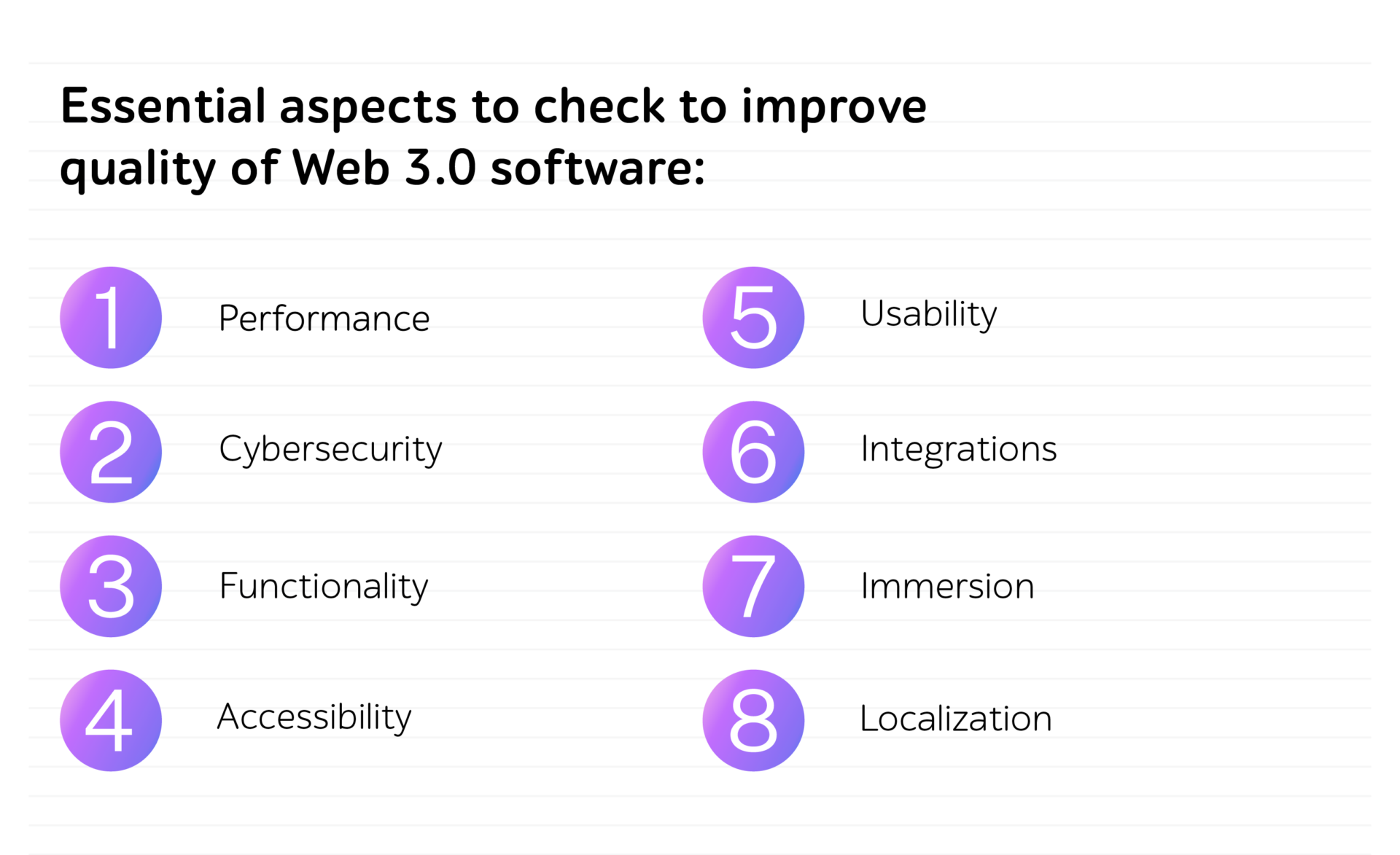
On the way to Web 3.0: key software testing aspects for seamless digital experiences. Part 2
The article was first published on a1qa’s LinkedIn. To read more about trends, QA news, and tech, follow our LinkedIn page.
Unpacking web 3.0 testing
In the part 1 of the article, we touched upon the meaning of Web 3.0 and its benefits for businesses regardless of the industry.
By being an evolution of the Internet, the metaverse is a highly complicated three-dimensional world that needs to operate accurately to provide impeccable immersive experiences.
So today, we’d like to walk you through the 8 most significant software testing aspects for ensuring the sound operation of Web 3.0 software.

1. Performance
The metaverse is quickly picking up steam worldwide – the overall number of followers of Roblox, Minecraft, or Fortnite exceeds 400 million, while in less than 10 years, we’ll witness 1.4 billion mobile AR users.
Just imagine what will happen if they all access software simultaneously.
Will it cope with peak load and remain operable?
Will it be able to sustain such a load every day?
What load limits does it have?
Server- and client-side performance testing helps find any limitations and bottlenecks (including latency issues), as well as ensure high speed, stability, responsiveness, and scalability of the metaverse under peak load conditions.
2. Cybersecurity
When adopting the metaverse, companies can confront multiple, completely novel challenges related to its security.
For instance, vulnerability attacks to achieve desired access, avatars tracking the virtual location of users, identity frauds that ruin people’s reputations, NFTs hijacking attack simulations to steal financial data, and copying digital stores to deceive consumers, just to name a few.
With the help of penetration testing, vulnerability assessment, and social engineering, you can simulate diverse attacks to spot vulnerabilities and decrease the above-mentioned risks.
3. Functionality
Functional testing eliminates major and critical software issues before going live. It also ensures that features (for instance, authentication, payments, interaction with other users, proper work of audio and video, etc.) work as expected and comply with set requirements. Therefore, QA manual engineers apply from smoke to acceptance testing and validate defects to confirm that the reported issues are fixed.
4. Accessibility
The WHO states that there are 1.3 billion people across the globe with different disabilities. To offer an impeccable digital experience to all of them, organizations should confirm that the software meets global accessibility standards, such as the Web Content Accessibility Guidelines or the Americans with Disabilities Act.
Therefore, we suggest ensuring that the metaverse provides audio or visual hints, has an alternative to controlling movements; the content is readable/easily understandable, and that everyone can successfully navigate the software.
5. Usability
Usability testing at the early implementation stage is the best variant to understand the ways real users interact with the software, what problems they face; assess how much time they spend on completing diverse tasks, and evaluate their satisfaction levels.
During testing of the metaverse software, the QA experts check whether the platform meets user expectations and is intuitive enough. They also identify flaws in interface design and logic, verify the simplicity of user journeys, make sure the quality of users’ locomotion is high, and more.
6. Integrations
To provide high interoperability of the metaverse and detect issues in the business logic of the software as soon as possible, it’s important to verify the quality of APIs.
Tests simulate end-user behavior, launch a chain of API calls, and help ascertain that APIs send requests and return the responses with the correct data.
7. Immersion
Immersion is especially significant for the metaverse ecosystem. If the level of immersion that the software provides is too high, end users are likely to experience cybersickness with unpleasant symptoms as headache, dizziness, eyestrain, nausea, etc. On the contrary, insufficient immersion will make it harder for users to fully delve into the metaverse.
The QA specialists ensure that while working with the metaverse, users don’t experience any discomfort and can fully plunge into the virtual world.
8. Localization
The QA teams focus on localizing the metaverse to provide end users with access to content in their native languages and make sure it’s tailored to the cultural specifics of their homelands. For that, they verify texts embedded into graphics, figures and currency, voiceover, subtitles, make sure that graphics and colors comply with the specifics of the target region.
Considering that the metaverse is a new, while at the same time a rapidly developing market, companies should often verify the quality of existing functionality.
Manual testing only can be challenging and time-consuming. To decrease overall testing time, optimize QA costs, increase test coverage, and reduce the probability of human error, organizations can make use of automated QA workflows.
Conclusion
Web 3.0 provides great opportunities for businesses from multiple industries due to decentralization, smart contracts, AI, advanced connectivity, semantic upgrade, better engagement, and uninterrupted service.
However, this technology is still rather complicated and challenging to introduce. To ease the process and ensure seamless digital experiences, companies can supplement the development activities with need-driven quality assurance – from functional testing to test automation.
Reach out to our experts to talk about your QA related issues.








